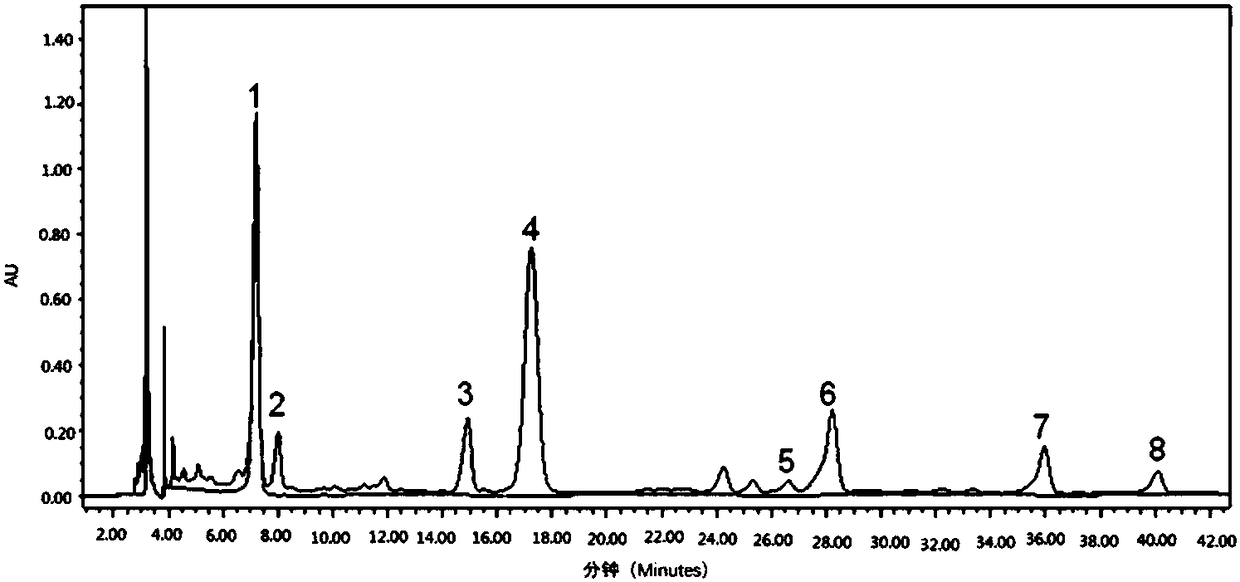A method for improving the active ingredient of honeysuckle
The technology of active ingredient and honeysuckle is applied in the field of improving the active ingredient of honeysuckle by photoenzyme induction technology, which can solve the problems of unenvironmental protection of light pollution, low application value, weak penetration of ultraviolet light, etc., and achieves short ultraviolet irradiation time and high efficiency. , suitable for the effect of large-scale industrial production
- Summary
- Abstract
- Description
- Claims
- Application Information
AI Technical Summary
Problems solved by technology
Method used
Image
Examples
experiment example 1
[0038] Construction of Fingerprint of Total Extract of Lonicerae japonica
[0039] (1) Freshly isolated honeysuckle flower buds are dried and pulverized, and passed through a 40-mesh medicine sieve. Weigh 1.0g, weigh it accurately, wrap it with filter paper and put it in a jar, add 200ml of methanol and place it in an ultrasonic generator for ultrasonic extraction for 60min (the temperature is controlled at about 30°C), pour out the supernatant, and add 100ml of methanol Continue to extract until colorless, combine the supernatants obtained twice, evaporate to dryness (60° C.) with a rotary evaporator, and dilute the residue into a 10 ml volumetric flask with methanol. After shaking well, take 1.5 mL, centrifuge at room temperature 10000 rpm for 10 minutes, pass the supernatant through a 0.45 μm filter membrane, analyze by HPLC, and finally optimize the fingerprint spectrum of the total extract of Clematis paniculata by changing the mobile phase. The chromatographic condition...
experiment example 2
[0047] Changes of fingerprints under different induction conditions:
[0048] After the induction was completed according to the conditions listed in Table 1, both the examples and the comparative examples were cultured under suitable conditions (temperature at 25° C. and humidity at 60%) completely protected from light. After 24 hours of cultivation, the honeysuckle was dried in an oven (60° C.), crushed, and passed through a 40-mesh medicine sieve. According to the method for establishing the fingerprints of the total extract of Flos Lonicerae Flos Lonicerae described in Experimental Example 1 above, the fingerprints of the examples and comparative examples were established and compared and analyzed. The results are shown in Table 3 and Table 4.
[0049] It can be known from the results that the content of caffeoylquinic acid compounds and iridoids in Lonicerae japonica active ingredients changed the most under the conditions of freezing for 1 hour, C0.5A0.5B0.5 ultraviolet ...
experiment example 3
[0057] Small scale industrial experiment:
[0058] (1) Get 200kg of fresh isolated honeysuckle;
[0059] (2) Put 200kg of honeysuckle into -20°C freezer for 1 hour;
[0060] (3) After the freezing is completed, put the honeysuckle layered into the ultraviolet radiation cabinet, and under the condition of 28°C, C0.5A0.5B0.5 ultraviolet radiation is irradiated alternately;
[0061] (4) After irradiating, take a sample, according to the method established by the total extract fingerprint of Flos Lonicerae Flos Lonicerae described in the above experimental example 1, set up the fingerprint, and compare and analyze, the results are shown in the experimental example 3 in table 3 and table 4.
PUM
 Login to View More
Login to View More Abstract
Description
Claims
Application Information
 Login to View More
Login to View More - R&D
- Intellectual Property
- Life Sciences
- Materials
- Tech Scout
- Unparalleled Data Quality
- Higher Quality Content
- 60% Fewer Hallucinations
Browse by: Latest US Patents, China's latest patents, Technical Efficacy Thesaurus, Application Domain, Technology Topic, Popular Technical Reports.
© 2025 PatSnap. All rights reserved.Legal|Privacy policy|Modern Slavery Act Transparency Statement|Sitemap|About US| Contact US: help@patsnap.com



